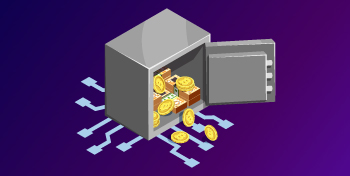The crypto community is looking forward to the full update of the Ethereum blockchain, which promised so many grandiose changes that will allow the platform to fundamentally change the very concept of the crypto space. But what is ETH 2.0?
On the NFT wave
Recently, it has been impossible to avoid all the hype surrounding non-fungible tokens (NFTs), which have been rising in the news for setting really insane prices.
NFTs are digital tokens that represent digital assets. They are stored on the blockchain and contain an immutable record of who they belong to. They are created using smart contracts and can be encoded in such a way that when selling, part of the sale price goes to the original creator, even if he is not the seller at the time. Thus, many artists and musicians use them to sell their work – again without the need for intermediaries.
Opinions on the NFT are divided. Some see them as a promising step toward returning copyright to creators and properly rewarding them for their work. Others see them more as a sign that Satan and his legions may finally be at the gate. However, there is no denying that Ethereum is once again the driving force behind this new crypto sector.
Two new Ethereum token standards, ERC – 721 and ERC-1155, were developed to create NFT, while most of them are purchased using ETH and stored on the Ethereum blockchain. It seems that for every new innovation in cryptocurrency, Ethereum is buzzing in the background.
Too popular for your own good
Ethereum has had its share of setbacks. As a result of a hack in 2016 that exploited a vulnerability in one of the projects built on its basis, $50 million worth of ETH was stolen. The decision was made to split the Ethereum blockchain (a process known as a hard fork) to recover the stolen funds. The fork became known as Ethereum Classic, and the project is still active today.
Hacks and hard forks are an integral part of cryptocurrency life, and Ethereum has remained relatively unscathed after encountering them. However, more relevant is the fact that the Ethereum network is currently experiencing a huge load of all the traffic that it has to cope with. Transaction fees are off the charts
This problem has become so acute that the Ethereum network can sometimes fall into disrepair. Transaction speeds have dropped to the crawl level (the network can only process 15 transactions per second), and the fees paid for executing these transactions (known as “gas fees”) can be astronomical during heavy usage. In short, the project has become a victim of its own success, weighed down by all the users it has attracted in its short lifetime.
This state of affairs has been going on for some time and has led to the creation of a number of projects that seek to displace Ethereum from its high position. These “Ethereum killers” include the likes of Charles Hoskinson’s Cardano and Gavin Wood’s Polkadot, which are developer blockchains similar to Ethereum but designed with much higher transaction throughput and the ability to handle more traffic.
As the first developers of Ethereum, both Hoskinson and Wood saw that as the project grew, there would be problems with scalability. While neither Cardano nor Polkadot are yet ready to challenge Ethereum’s dominance, they are built without its flaws and will continue to grow if Ethereum can’t put its house in order soon.
Understanding the Issues of Ethereum
By now, you’ve already read the word “blockchain” several times during this passage alone. If you’ve ever been involved in cryptocurrency, you’ve probably heard a lot more about it. Blockchain technology is at the heart of the entire cryptocurrency. It provides the means to securely store and record all of the cryptocurrency’s transactional and historical data, ensuring that it is never tampered with. Thus, the integrity of the system is preserved, and dishonesty becomes almost impossible.
The most famous blockchain, of course, is Bitcoin. A network of individual computers (nodes) is scattered around the world, and each node verifies every transaction that occurs on the network. After checking a certain number of transactions, they are grouped into a block.
To ensure the security of the network, each block is encoded with a long sequence of letters and numbers, known as a hash. Each block carries its own hash and a copy of the hash code of the previous block. These matching hashes allow you to add a new block to the chain. When a new block is created, the user who created it is rewarded with a set amount of Bitcoins. These block producers are known as miners, and the process of deciding which miner creates a new block is known as network consensus.
To get the corresponding hash, you need to solve a complex mathematical problem that can only be solved using brute force computing power. The more energy the miner uses, the more chances he has to solve the problem first and be able to get a new block. This is why many are expressing concern about the huge amount of electricity consumed by the Bitcoin network.
This method of achieving network consensus is known as Proof-of-Work (PoW), with the work in question representing the computing power expended to achieve the corresponding hash number.
The Bitcoin code was written in such a way that the complexity of the problems that need to be solved to create a new block increased as more blocks were mined. As a result, the Bitcoin network has become slower and more energy-intensive as its popularity has grown. The proof-of-work consensus mechanism has become obsolete as Bitcoin has grown.
The Ethereum network is now suffering from problems similar to the Bitcoin network, because it also uses proof of work to achieve network consensus. High demand and heavy traffic have made it harder to mine blocks on Ethereum, which means the whole process has become slower and more expensive.
Ethereum miners need to use more energy to create blocks and thus allow the network to move forward, which means that the gas fees they charge have become higher. As a result, the network slows down to a crawl when many people try to use it.
These are the problems that Ethereum 2.0 is designed to solve.
ETH 2.0-Problem Solving

For Ethereum to become popular and serve all of humanity, it must solve the problem of scalability, security, and sustainability.
This is the stated goal of Ethereum for ETH 2.0 and the recognition that the current state of the network is inadequate. The process of upgrading Ethereum to ETH 2.0 is long and should not be completed until next year. It is divided into three separate stages, which we will consider in a minute. Before that, we need to understand the new type of blockchain consensus mechanism that Ethereum is moving to.
We have already noted the shortcomings of the proof-of-work blockchain. To combat this waste and inefficiency, Ethereum is moving towards becoming a PoS blockchain, where consensus is achieved in a much more efficient and less intensive way.
In a proof-of-stake blockchain, those nodes that want to be able to mine new blocks and claim rewards can put their cryptocurrency on the stack to get a chance to become a so-called “validator”. It works a lot like a lottery: the more tickets you buy (the more you delegate), the more chances you have of winning. A single validator is then randomly selected to mine a new block and receive a reward, which is usually a reduction in all fees paid for transactions contained in the block.
This method of reaching consensus saves several miners from having to use a huge amount of energy to get permission to mine a new block. However, the transition of Ethereum to this new system is not easy and will take place in three separate stages.
Stage 1: Lighthouse Chain
This first phase was actually launched in December 2020, causing considerable excitement in the Ethereum community and beyond, as it seemed that the transition to ETH 2.0 had finally begun.
The beacon chain is focused on using staking on Ethereum. This will allow participants to run the validator software and participate in the PoS blockchain. The Ethereum team hopes to attract as many validators as possible so that control of the network is not concentrated in the hands of too few validator nodes. It is hoped that this decentralization will solve the problem of network security.
The functionality of the Beacon Chain will also help pave the way for the next stage of ETH 2.0, which will depend on the availability of a PoS system.
Stage 2: Sharding
To improve the scalability of Ethereum and allow it to process more transactions, additional chains, known as shard chains, will be introduced to ease the load on the main chain. It is planned that eventually 64 chains of segments will work in parallel, which will significantly increase the amount of traffic that the network as a whole is able to handle.
The shard chains will eventually be randomly assigned by the Beacon Chain validators. This will further increase the security of the network, since no two validators can collude to capture the shard. Spreading the network across these segment chains will not only increase speed and security, but will eventually allow people to run the Ethereum client from a laptop or smartphone, thereby further securing the network.
Sharding is expected sometime this year”, depending on how quickly the work progresses after the Beacon Chain launch”. This will allow for the final stage of ETH 2.0.
Stage 3: Docking
Both the Beacon Chain and the segment chains will operate separately from the main Ethereum network, which will still use proof-of-work consensus. The docking will join the main network with the Beacon Chain and segment chains, eventually moving the entire Ethereum network to consensus PoS.
This final phase of the long-awaited Ethereum upgrade is expected to take place either later this year or in early 2022.
Infinity is not the limit?

Amid all the hype surrounding the rise in Bitcoin prices over the past year, and the bull market seen throughout the cryptocurrency market, it has not gone unnoticed that the price of ETH has also surged, by an astounding 1,200%. This dwarfs Bitcoin’s 850% growth, and reflects the importance of Ethereum to the entire cryptocurrency universe.
To a large extent, the growth of ETH can be attributed to the prevailing market sentiment: the cryptocurrency as a whole is experiencing a boom year, while the rest of the financial world was close to collapse. However, much of the continued success of ETH may be due to excitement about the advent of ETH 2.0, and it’s no surprise that the price actually started to rise after the Beacon Chain rollout in December.
The fact is that anyone with even a little practical knowledge about cryptocurrencies knows how big Ethereum has become, and how important it is to what is happening in the crypto industry. Half of the existing projects probably wouldn’t exist without it, and any balanced portfolio would almost certainly contain at least one asset running on Ethereum.
Perhaps the best indicator of Ethereum’s success is the number of projects that are eager to get down to business as it chugs along and slowly reaches for its new dawn. Cardano and Polkadot have already been mentioned, but Algorand, Stellar, Tezos, and NEAR Protocol, among others, are targeting the Ethereum crown. The original blockchain of smart contracts cannot afford to stop there.
ETH 2.0 appeared a long time ago, but it has not yet been fully implemented. Despite the fact that some fixes have been made to the network during this time, Ethereum is still far from realizing its huge potential.
But, assuming that the cautious rollout of ETH 2.0 goes according to plan, Ethereum looks set to reach new heights in the coming years. Many people in the crypto space feel that the best is yet to come. At least those who aren’t too busy shilling Bitcoins.


